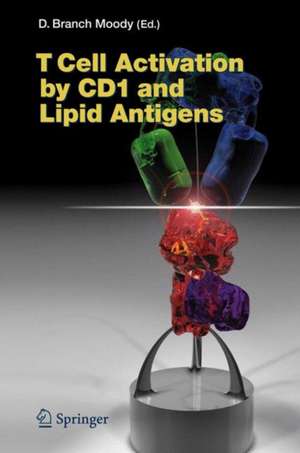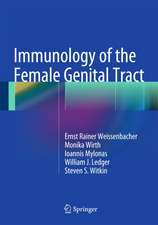T Cell Activation by CD1 and Lipid Antigens: Current Topics in Microbiology and Immunology, cartea 314
Editat de Branch D. Moodyen Limba Engleză Hardback – 14 mai 2007
| Toate formatele și edițiile | Preț | Express |
|---|---|---|
| Paperback (1) | 986.70 lei 38-44 zile | |
| Springer Berlin, Heidelberg – 30 noi 2010 | 986.70 lei 38-44 zile | |
| Hardback (1) | 1104.84 lei 43-57 zile | |
| Springer Berlin, Heidelberg – 14 mai 2007 | 1104.84 lei 43-57 zile |
Din seria Current Topics in Microbiology and Immunology
- 18%
 Preț: 962.03 lei
Preț: 962.03 lei - 5%
 Preț: 1123.13 lei
Preț: 1123.13 lei -
 Preț: 499.76 lei
Preț: 499.76 lei - 5%
 Preț: 967.79 lei
Preț: 967.79 lei - 18%
 Preț: 1118.62 lei
Preț: 1118.62 lei - 5%
 Preț: 717.00 lei
Preț: 717.00 lei - 5%
 Preț: 712.97 lei
Preț: 712.97 lei - 5%
 Preț: 709.51 lei
Preț: 709.51 lei - 5%
 Preț: 709.51 lei
Preț: 709.51 lei - 5%
 Preț: 721.19 lei
Preț: 721.19 lei - 5%
 Preț: 359.78 lei
Preț: 359.78 lei - 5%
 Preț: 711.88 lei
Preț: 711.88 lei - 5%
 Preț: 774.81 lei
Preț: 774.81 lei - 15%
 Preț: 640.06 lei
Preț: 640.06 lei - 5%
 Preț: 717.00 lei
Preț: 717.00 lei - 5%
 Preț: 360.34 lei
Preț: 360.34 lei - 5%
 Preț: 707.69 lei
Preț: 707.69 lei - 5%
 Preț: 717.56 lei
Preț: 717.56 lei - 5%
 Preț: 716.28 lei
Preț: 716.28 lei - 5%
 Preț: 717.20 lei
Preț: 717.20 lei - 5%
 Preț: 711.32 lei
Preț: 711.32 lei - 5%
 Preț: 711.88 lei
Preț: 711.88 lei - 5%
 Preț: 718.29 lei
Preț: 718.29 lei - 5%
 Preț: 709.51 lei
Preț: 709.51 lei - 5%
 Preț: 369.84 lei
Preț: 369.84 lei - 5%
 Preț: 712.25 lei
Preț: 712.25 lei - 5%
 Preț: 716.45 lei
Preț: 716.45 lei - 5%
 Preț: 706.60 lei
Preț: 706.60 lei - 5%
 Preț: 711.52 lei
Preț: 711.52 lei - 5%
 Preț: 713.54 lei
Preț: 713.54 lei - 5%
 Preț: 720.47 lei
Preț: 720.47 lei - 5%
 Preț: 725.42 lei
Preț: 725.42 lei - 5%
 Preț: 708.06 lei
Preț: 708.06 lei - 5%
 Preț: 713.70 lei
Preț: 713.70 lei - 5%
 Preț: 705.83 lei
Preț: 705.83 lei - 5%
 Preț: 710.96 lei
Preț: 710.96 lei - 5%
 Preț: 723.93 lei
Preț: 723.93 lei - 5%
 Preț: 707.69 lei
Preț: 707.69 lei - 5%
 Preț: 715.35 lei
Preț: 715.35 lei - 5%
 Preț: 709.87 lei
Preț: 709.87 lei - 5%
 Preț: 359.05 lei
Preț: 359.05 lei - 5%
 Preț: 374.20 lei
Preț: 374.20 lei - 15%
 Preț: 635.31 lei
Preț: 635.31 lei - 5%
 Preț: 707.86 lei
Preț: 707.86 lei - 5%
 Preț: 721.96 lei
Preț: 721.96 lei - 15%
 Preț: 632.88 lei
Preț: 632.88 lei - 15%
 Preț: 632.05 lei
Preț: 632.05 lei - 15%
 Preț: 642.83 lei
Preț: 642.83 lei - 5%
 Preț: 709.14 lei
Preț: 709.14 lei
Preț: 1104.84 lei
Preț vechi: 1162.99 lei
-5% Nou
Puncte Express: 1657
Preț estimativ în valută:
211.41€ • 221.29$ • 175.96£
211.41€ • 221.29$ • 175.96£
Carte tipărită la comandă
Livrare economică 31 martie-14 aprilie
Preluare comenzi: 021 569.72.76
Specificații
ISBN-13: 9783540695103
ISBN-10: 3540695109
Pagini: 348
Ilustrații: VII, 348 p.
Dimensiuni: 155 x 235 x 22 mm
Greutate: 0.68 kg
Ediția:2007
Editura: Springer Berlin, Heidelberg
Colecția Springer
Seria Current Topics in Microbiology and Immunology
Locul publicării:Berlin, Heidelberg, Germany
ISBN-10: 3540695109
Pagini: 348
Ilustrații: VII, 348 p.
Dimensiuni: 155 x 235 x 22 mm
Greutate: 0.68 kg
Ediția:2007
Editura: Springer Berlin, Heidelberg
Colecția Springer
Seria Current Topics in Microbiology and Immunology
Locul publicării:Berlin, Heidelberg, Germany
Public țintă
ResearchCuprins
Molecular Biology.- Evolutionary Biology of CD1.- Architecture of CD1 Proteins.- Structure and Biology of Self Lipid Antigens.- Structures and Functions of Microbial Lipid Antigens Presented by CD1.- Cellular Biology.- CD1 Expression on Antigen-Presenting Cells.- Pathways of CD1 and Lipid Antigen Delivery, Trafficking, Processing, Loading, and Presentation.- TCR-Mediated Recognition of Glycolipid CD1 Complexes.- Development and Selection of V?14i NKT Cells.- Disease.- CD1-Restricted T Cells in Host Defense to Infectious Diseases.- NKT Cells and Autoimmune Diseases: Unraveling the Complexity.- iNKT Cells in Allergic Disease.- CD1-Restricted T Cells and Tumor Immunity.- Harnessing NKT Cells for Therapeutic Applications.
Textul de pe ultima copertă
For decades, T cells were thought to solely respond to protein-derived antigens. However, the discovery of the CD1 antigen presenting system shows how antigen presenting cells can display lipid antigens to T cells. Crystal structures show that CD1 proteins accomplish this function by inserting lipids into a hydrophobic groove on the distal surface of the protein, forming CD1-lipid complexes that act as ligands for T cell receptors. CD1-reactive T cells with conserved (NK T cells) or diverse T cell receptors possess cytokine secretion and other effector mechanisms that influence many aspects of immune response. There is increasing evidence that the CD1 system has been conserved throughout mammalian evolution and is capable of presenting structurally diverse diacyglycerol, sphingolipid, polyisoprenol and lipopeptide antigens. These features of CD1 antigen presentation systems now point to a new and expanded view of the natural function of ab T cells, which involves surveillance of both the protein and lipid components of target cells. Further, cellular systems that were previously considered to have functions in lipid metabolism can now be studied in context of their immunological functions. This volume provides a comprehensive discussion of these basic aspects of CD1 biology and summarizes the most recent research into the role of CD1 in infectious, autoimmune, allergic and neoplastic disease.
Caracteristici
Includes supplementary material: sn.pub/extras









